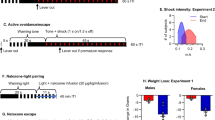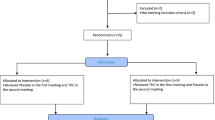Abstract
Systemic administration of RB 101, a complete inhibitor of the enkephalin degrading enzymes, has been reported to induce naltrindole-reversed anti-depressant-like effects in the conditioned suppression of motility (CSM) test in mice. The selective CCKB antagonist L-365,260 also elicits the same naltrindole-blocked responses on CSM. The aim of this study was therefore to investigate the possible modulation of RB 101 induced behavioral responses by activation or blockade of CCK receptors. Thus, the effects induced by RB 101 administered alone or associated with an ineffective dose of a selective CCKB agonist (BC 264), a CCKB antagonist (L-365,260) or a CCKA antagonist (L-364,718), were evaluated on the CSM in mice. RB 101 alone decreased the stress-induced loss of motility, as previously reported. The antidepressant-like effect of RB 101 was potentiated by L-365,260, and suppressed by BC 264 and to a lesser extent by L-364,718. The facilitatory effect induced by L-365,260 on RB 101 responses was blocked by the delta selective antagonist naltrindole. All these effects occurred only in shocked animals. The present results suggest that the activation of CCKA and CCKB receptors by endogenous CCK, could play an opposite role in the control of behavioral responses induced by endogenous enkephalins. Delta opioid receptors seem to be selectively involved in this interaction.
Similar content being viewed by others
References
Baamonde A, Dauge V, Ruiz-Gayo M, Fulga IG, Turcaud S, Fournie-Zaluski MC, Roques BP (1992) Antidepressant-type effects of endogenous enkephalins protected by systemic RB 101 are mediated by opioidδ and dopamine D1 receptor stimulation. Eur J Pharmacol 216:157–166
Barber NS, Dourish CT, Hill DR (1989) The role of CCK, caerulein, and CCK antagonists in nociception. Pain 39:307–328
Benoliel JJ, Bourgoin S, Mauborgne A, Legrand JC, Hamon M, Cesselin F (1991) Differential inhibitory/stimulatory modulation of spinal CCK release byμ andδ opioid agonists, and selective blockade ofμ-dependent inhibition byκ receptor stimulation. Neurosci Lett 124:204–207
Benoliel JJ, Mauborgne A, Bourgoin S, Legrand JC, Hamon M, Cesselin F (1992) Opioid control of CCK-like material from the rat substantia nigra. J Neurochem 58:916–922
Butcher SP, Varro A, Kelly JS, Dockray GJ (1989) In vivo studies on the enhancement of cholecystokinin release in the rat striatum. Brain Res 505:119–122
Calenco-Choukroun G, Daugé V, Gacel G, Roques BP (1991) Lesion of dopamine mesolimbic neurons blocks behavioral effects induced by the endogenous enkephalins but not by aμ-opioid receptor agonist. Eur J Pharmacol 209:267–271
Cesselin F, Bourgoin S, Artaud F, Hamon M (1984) Basic and regulatory mechanisms of in vitro release of Met-enkephalin from the dorsal zone of the rat spinal cord. J Neurochem 43:763–773
Chang RLS, Lotti VJ (1986) Biochemical and pharmacological characterization of an extremely potent and selective non-peptide cholecystokinin antagonist. Proc Natl Acad Sci USA. 83:4923–4926
Chang RLS, Lotti VJ, Chen TB, Kunkel KA (1986) Characterization of the binding of [3H]-(±)-L-364,718: a new potent, nonpeptide cholecystokinin antagonist radioligand selective for peripheral receptors. Mol Pharmacol 30:212–217
Charpentier B, Durieux C, Peleprat D, Dor A, Reibaud M, Blanchard JC, Roques BP (1988) Enzyme resistant CCK analogs with high affinities for central receptors. Peptides 9:835–841
Cooper SJ (1991) Interactions between endogenous opioids and dopamine: implications for reward and aversion. In: Willner P, Scheel-Kruger (eds) The mesolimbic dopaminergic system: from motivation to action. John Wiley,
Daugé V, Rossignol P, Roques BP (1988) Comparison of the behavioural effects induced by administration in rat nucleus accumbens or nucleus caudatus of selective m and dopioid peptides or kelatorphan an inhibitor of enkephalin-degrading enzymes. Psychopharmacology 96:343–352
De Felipe MC, Jiménez I, Castro A, Fuentes JA (1989) Antidepressant action of imipramine and iprindole in mice is enhanced by inhibitors of enkephalin-degrading peptidases. Eur J Pharmacol 159:175–180
Derrien M, Noble F, Maldonado R, Roques BP (1993) CCK-A or CCK-B receptors activation lead to antinociception and to hyperalgesia respectively: evidence for an indirect interaction with the opioidergic system. Neurosci Lett 160:193–196
Derrien M, Durieux C, Roques BP (1994) Antidepressant-like effects of CCK-B antagonists in mice: antagonism by Naltrindole. Br J Pharmacol 111:956–960
Ding XZ, Bayer BM (1993) Increases of CCK mRNA and peptide in different brain areas following acute and chronic administration of morphine. Brain Res 625:139–144
Dockray GJ (1976) Immunochemical evidence of cholecystokinin-like peptides in brain. Nature 264:568–570
Dourish CT, O'Neill MF, Coughlan J, Kitchener SJ, Hawley D, Iversen SD (1990) The selective CCK-B receptor antagonist L-365,260 enhances morphine analgesia and prevents morphine tolerance in the rat. Eur J Pharmacol 176:35–44
Durieux C, Ruiz-Gayo M, Pelaprat D, Roques BP (1986) Investigation on the metabolism of CCK8 analogues by rat brain slices. Neuropeptides 7:1–9
Durieux C, Ruiz-Gayo M, Couringer PJ, Bergeron F, Ducos B, Roques BP (1992) [3H]pBC 264, a suitable probe for studying cholecystokinin-β receptors binding characteristics in rodent brains and comparison with [3H]SNF 8702. Mol Pharmacol, 41:1089–1095
Faris PL, Komisaruk B, Waitkins LR, Mayer DJ (1983) Evidence for the neuropeptide cholecystokinin as an antagonist of opiate analgesia. Science 219:1449–1451
Fournié-Zaluski MC, Coric P, Turcaud S, Lucas E, Noble F, Maldonado R, Roques BP (1992) Mixed-inhibitor prodrug as a new approach towards systemically active inhibitors of enkephalin degrading enzymes. J Med Chem 35:2474–2481
Gall C, Lauterborn J, Burks D, Seroogy K (1987) Co-localization of enkephalin and cholecystokinin in discrete areas of rat brain. Brain Res 403:403–408
Gaudreau P, Lavigne GJ, Quirion R (1990) Cholecystokinin antagonists proglumide, Lorglumide and benzotrip, but not L-365,718 interact with brain opioid binding sites. Neuropeptides 16:51–55
Hill DR, Campbell NJ, Shaw TM, Woodruff GN (1987) Autoradiographic localization and biochemical characterization of peripheral type CCK receptors in rat CNS using highly selective nonpeptide antagonists. J Neurosci 7:2967–2976
Hökfelt T, Rehfeld JF, Skirboll L, Ivemark B, Goldstein M, Markey (1980) Evidence for coexistence of dopamine and CCK in mesolimbic neurons. Nature 285:476–478
Innis RB, Snyder SH (1980) Distinc cholecystokinin receptors in brain and pancreas. Proc Natl Acad Sci USA 77:6917–6921
Itoh S, Katsuura G, Maeda Y (1982) Caerulein and cholecystokinin suppressβ-endorphin-induced analgesia in the rat. Eur J Pharmacol 80:421–425
Kameyama T, Nagasaka M (1982) Effects of apomorphine and diazepam on a quickly learned conditioned suppression in rats. Pharmacol Biochem Behav 17:59–63
Kameyama T, Nagasaka M, Yamada K (1985) Effects of antide-pressant drugs on a quickly learned conditioned suppression responses in mice. Neuropharmacology 24:59–63
Kopin AS, Lee YM, McBride EW, Miller LJ, Lu M, Lin HY, Kolakowski LF, Beinborn M (1992) Expression cloning and characterization of the canine parietal cell gastrin receptor. Proc Natl Acad Sci USA 89:3605–3609
Ladurelle N, Keller G, Roques BP, Daugé V (1993) Effects of CCK8 and of a CCKB-selective agonist BC264 on extracellular dopamine content in the posterieur nucleus accumbens: a microdialysis study in freely moving rats. Brain Res 628:254–262
Lanaud P, Popovici T, Normand E, Lemoine C, Bloch B, Roques BP (1989) Distribution of CCK mRNA in particular regions (hippocampus, periaqueducal grey and thalamus) of the rat by in situ hybridization. Neurosci Lett 104:38–42
Lavigne GJ, Millington WR, Mueller GP (1992) The CCK-A and CCK-B receptor antagonists, devazepide and L-365,260, enhance morphine antinociception only in non-acclimated rats exposed to a novel environment. Neuropeptides 21:119–129
Maldonado R, Daugé V, Feger J, Roques BP (1990) Chronic blockade of D2 but not D1 dompamine receptors facilitates behavioural responses to endogenous enkephalins protected by kelatorphan administered in the accumbens in rats. Neuropharmacology 29:215–223
Maldonado R, Derrien M, Noble F, Roques BP (1993) Association of the peptidase inhibitor and a CCK-B antagonist strongly enhances antinociceptive responses. Neuroreport 4:947–950
Moran TH, Robilson MS, Goldrich MS, McHugh PR (1986) Two brain cholecystokinin receptors for behavioural actions. Brain Res 362:175–179
Nabeshima T, Katoh A, Kameyama T (1988) Inhibition of enkephalin degradation attenuated stress-induced motor suppression (conditioned suppression of motility. J Pharmacol Exp Ther 244:303–309
Noble F, Soleilhac JM, Soroca-Lucas E, Turcaud S, Fournié-Zaluski MC, Roques BP (1992) Inhibition of the enkephalinmetabolizing enzymes by the first systematically active mixed inhibitor prodrug RB101 induces potent analgesic responses in mice and rats. J Pharmacol Exp Ther 261:181–190
Noble F, Derrien M, Roques BP (1993) Modulation of opioid antinociception by CCK at the supraspinal level: evidence of regulatory mechanisms between CCK and enkephalin systems in the control of pain. Br J Pharmacol 109:1064–1070
Noble F, Smadja C, Roques BP (1994) Role of endogenous cholecystokinin in the facilitation ofμ-mediated antinociception byδ-agonist. J Pharmacol Exp Ther 271:1127–1134
Pélaprat D, Broer Y, Studler JM, Peschanski M, Tassin JP, Glowinski J, Rostène W, Roques BP (1987) Autoradiography of CCK receptors in the rat brain using [3H]Boc[Nle28,31] CCK27–33 and [125I] Bolton-Hunter CCK8. Functional significance of subregional distributions. Neurochem Int 10:495–508
Pohl M, Benoliel JJ, Bourgoin S, Lombard MC, Mauborgne A, Taquet H, Carayon A, Besson JM, Cesselin F, Hamon M (1990) Regional distribution of calcitonin gene-related peptide-, substance P, cholecystokinin-, Met-enkephalin-, and dynorphin A (1–8)-like materials in the spinal cord and dorsal root ganglia of adult rats: effects of dorsal rhizotomy and neonatal capsaicin. J Neurochem 55:1122–1130
Portoghese PS, Sultana M, Takemori AE (1988) Naltrindole, a highly selective and potent non-peptideδ-opioid receptor antagonist. Eur J Pharmacol 146:185–186
Roques BP, Daugé V, Gacel G, Fournié-Zaluski MC (1985) Selective agonists and antagonists of delta opioid receptors and inhibitors of enkephalin metabolism. Potential use in treatment of mental illness. In Josiassen RC, Bridger WH, Weiss KJ, Stoff D, Simpson GM (eds) Biological psychiatry developments in psychiatry, vol 7. Elsevier, pp 287–289
Ruiz-Gayo M, Durieux C, Fournié-Zaluski MC, Roques BP (1992) Stimulation of ∂-opioid receptors binding of the cholecystokinin (CCK)-B-selective agonist [3H]pBC 264: evidence for a physiological regulation of CCKergic systems by endogenous enkephalins. J Neurochem 59:1805–1811
Saito A, Sankaran H, Goldfine ID, Williams JA (1980) Cholecystokinin receptors in the brain: characterization and distribution. Science 208:1155–1156
Sakamoto C, Williams JA, Godfine ID (1984) Brain CCK receptors are structurally distinct from pancreas CCK receptors. Biochem Biophys Res Commun 124:497–502
Tejedor-Real P, Micó JA, Maldonado R, Roques BP, Gibert-Rahola J (1993) Effect of mixed (RB 38A) and selective (RB 38B) inhibitors of enkephalins degrading enzymes on a model of depression in the rat. Biol Psychiatry 34:100–107
Valverde O, Maldonado R, Fournié-Zaluski MC, Roques BP (1994) CCK-B antagonists strongly potentiate antinociception mediated by endogenous enkephalins. J Pharmacol Exp Ther 270:77–88
Wang XJ, Hans JS (1990) Modification by cholecystokinin octapeptide of the binding ofμ-δ- andκ-opioid receptors. J Neurochem 55:1379–1382
Wank SA, Pisegna JR, Weerth A (1992) Brain and gastrointestinal cholecystokinin receptor family: structure and functional expression. Proc Natl Acad Sci USA 89:8691–8695
Watkins LR, Kinscheck IB, Mayer DJ (1985) Potentiation of morphine analgesia by the cholecystokinin antagonist proglumide. Brain Res 327:169–180
Wiesenfeld-Hallin Z, Xu XH, Hughes J, Horwell DC, Hökfelt T (1990) PD134308, a selective antagonist of cholecystokinin type B receptor, enhances the analgesic effect of morphine and synergistically interacts with intrathecal galanin to depress spinal nociceptive reflexes. Proc Natl Acad Sci USA 87:7105–7109
Willner P (1990) Animal models of depression: an overview. Pharmacol Ther 45:425–455
Wise RA (1983) Brain neuronal systems mediating reward processes. In: Smith JE, Lane JD (eds) Neurobiologie of opiate reward processes. Elsevier/North Holland Biomedical Press, Amsterdam, pp 405–437
Zimmerman M (1983) Guest editorial. Pain 16:109–110
Zhou Y, Sun YH, Zhang ZW, Han JS (1992) Accelerated expression of cholecystokinin gene in the brain of rats rendered tolerant to morphine. Neuroreport 3:1121–1123
Zuzel K, Rose C, Schwartz JC (1985) Assessment of the role of “enkephalinase” in cholecystokinin inactivation. Neuroscience 15:149–158
Author information
Authors and Affiliations
Rights and permissions
About this article
Cite this article
Smadja, C., Maldonado, R., Turcaud, S. et al. Opposite role of CCKA and CCKB receptors in the modulation of endogenous enkephalin antidepressant-like effects. Psychopharmacology 120, 400–408 (1995). https://doi.org/10.1007/BF02245811
Received:
Revised:
Issue Date:
DOI: https://doi.org/10.1007/BF02245811




